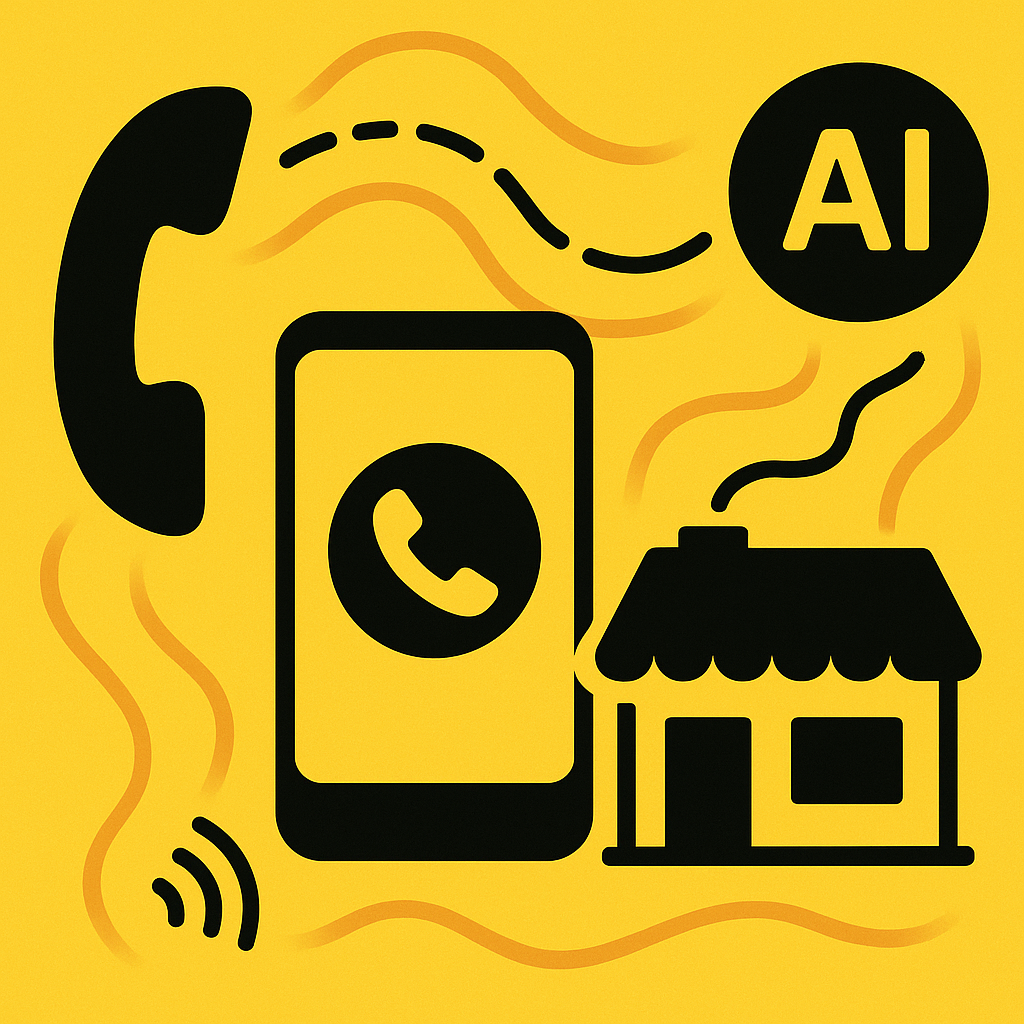
Every missed call is a missed opportunity. For small restaurants operating on razor-thin margins, those unanswered rings represent lost reservations, canceled takeout orders, and frustrated guests who might never call back. The numbers are sobering: industry data shows that restaurants typically miss 36% of incoming calls during peak hours, translating to thousands of dollars in lost revenue monthly.
But what if there was a way to flip those statistics? Recent data from Hostie AI's comprehensive 500,000-call study reveals that restaurants can dramatically improve their answer rates from 64% to 97% by deploying AI-powered phone concierge technology. (Hostie AI) This isn't just about answering more calls—it's about transforming how small restaurants handle guest communications while freeing up staff to focus on what they do best: creating exceptional dining experiences.
The restaurant industry is undergoing a technological revolution, with 79% of operators implementing or considering AI for various operational tasks. (Popmenu) For independent restaurants with fewer than 50 seats, this technology shift represents both an opportunity and a necessity. Labor costs increased by 34% in 2023, making automation essential for maintaining profitability. (Hostie AI ROI Study)
Before diving into the solution, let's quantify the problem. High-volume restaurants receive between 800 and 1,000 calls per month, which can disrupt service and overwhelm staff. (AI Restaurant Software Guide) For a typical 40-seat restaurant, here's what missed calls actually cost:
| Call Type | Average Value | Monthly Volume | Missed (36%) | Monthly Loss |
|---|---|---|---|---|
| Reservations | $85 per party | 200 calls | 72 calls | $6,120 |
| Takeout Orders | $32 per order | 300 calls | 108 calls | $3,456 |
| Event Inquiries | $450 per event | 20 calls | 7 calls | $3,150 |
| Total Monthly Loss | $12,726 |
These figures align with industry research showing that 63% of Americans prefer calling restaurants directly, and 89% would be open to using an AI agent for restaurant interactions. (Hostie AI Blog) When restaurants fail to answer, they're not just losing immediate revenue—they're potentially losing customers permanently, as over two-thirds of Americans would consider switching to competitors who provide better phone service.
Hostie AI's comprehensive analysis of 500,000 restaurant calls across partner establishments provides unprecedented insight into how AI voice technology transforms restaurant operations. The study, conducted across restaurants including Flour + Water and Slanted Door, reveals dramatic improvements in key performance metrics. (Hostie AI Introduction)
Answer Rate Transformation:
Revenue Impact:
The Slanted Door Group specifically saw a 56% boost in over-the-phone covers after implementing Hostie AI, demonstrating the real-world impact of improved call handling. (Slanted Door Case Study)
Hostie AI's success stems from its seamless integration capabilities. The platform connects with existing reservation systems like OpenTable and POS systems like Square and Toast in under 60 minutes. (Integration Guide) This rapid deployment means restaurants can start seeing results almost immediately without disrupting existing operations.
Understanding how AI transforms restaurant call handling requires examining the specific workflow improvements. Traditional phone systems create bottlenecks during peak service hours when staff are focused on in-person guests. AI voice technology eliminates these constraints through intelligent call routing and automated responses.
Hostie AI addresses these challenges through sophisticated voice recognition and natural language processing. The system can handle complex requests, from simple reservation changes to complicated order modifications and private event inquiries. (Hostie AI Features)
Automated Reservation Management:
Order Processing Excellence:
24/7 Availability:
The labor shortage crisis continues to challenge restaurants, with 60% of operators having difficulty filling positions and 39% losing revenue due to staffing shortages. (ROI Economics Study) AI voice technology provides immediate relief by handling routine communications, allowing human staff to focus on high-value guest interactions.
Host Position Optimization:
The median host wage in 2025 is $14.61 per hour, but AI can handle many traditional host responsibilities 24/7. (Cost Calculator) For an 80-seat bistro, this translates to significant cost savings while improving service consistency.
Server Efficiency Improvements:
Management Time Savings:
While AI handles routine communications, human staff remain crucial for complex problem-solving, relationship building, and the nuanced hospitality that defines exceptional restaurants. As one industry expert noted, "As a restaurant owner myself, I know how difficult it can be to balance being on the floor during peak service hours while managing inbound calls, texts and emails from potential guests." (Hostie AI Introduction)
Implementing AI voice technology doesn't require a complete system overhaul. Modern solutions like Hostie AI are designed to integrate with existing restaurant technology stacks, making adoption accessible for smaller establishments.
Reservation System Connectivity:
The integration process has been streamlined significantly, with restaurants able to connect Hostie AI with OpenTable and Toast POS systems to achieve zero-touch reservations. (Zero-Touch Integration) This means calls flow directly from the AI system to the POS and kitchen display systems without human intervention.
POS System Integration:
Communication Centralization:
Hostie provides a unified platform for managing calls, texts, and emails, streamlining all guest communications into a single interface. (Hostie AI Platform) This centralization eliminates the need to monitor multiple communication channels separately.
Week 1: Setup and Integration
Week 2-3: Testing and Optimization
Week 4+: Full Operation
To help restaurant operators understand the potential return on investment, we've developed a comprehensive metrics worksheet based on Hostie AI's real-world performance data. This calculator allows you to input your specific call volume and average ticket size to forecast payback periods.
Current Performance Metrics:
Cost Considerations:
40-Seat Restaurant Example:
These calculations demonstrate why AI-powered phone systems are generating such significant returns, with some restaurants seeing 700%+ ROI within the first year. (ROI Deep Dive)
Successful AI voice implementation requires more than just technology deployment. Restaurants that achieve the best results follow specific best practices that maximize both system performance and staff adoption.
Menu and Information Audit:
Staff Communication Strategy:
Call Flow Customization:
The AI system should reflect your restaurant's unique personality and service style. Hostie AI's platform allows for extensive customization to match your brand voice and specific operational needs. (When You Call a Restaurant)
Performance Monitoring:
Guest Experience Enhancement:
The AI restaurant software market in 2025 includes several key players, each with different strengths and target markets. (AI Software Buyer's Guide) Understanding these options helps restaurants make informed decisions about their technology investments.
| Platform | Best For | Starting Price | Key Differentiator |
|---|---|---|---|
| Hostie AI | Full-service restaurants | $199/month | Restaurant-built, comprehensive integration |
| Slang AI | Quick-service chains | Varies | Chain-focused features |
| Maple Voice | High-volume operations | Custom pricing | Enterprise-grade scaling |
Hostie AI stands out as being "designed for restaurants, made by restaurants," with founders who understand the unique challenges of restaurant operations firsthand. (Hostie vs Slang Comparison) This restaurant-centric approach shows in the platform's intuitive design and practical feature set.
Integration Capabilities:
Scalability Considerations:
Cost Structure:
The restaurant technology landscape continues to evolve rapidly, with AI becoming increasingly sophisticated and customer expectations rising accordingly. The global food automation market is projected to reach $14 billion by the end of 2024, with a potential 69% increase in AI and robotics use in fast food restaurants by 2027. (Q3 2025 Tech Trends)
Advanced Personalization:
Multi-Channel Integration:
Predictive Analytics:
Restaurants that invest in AI voice technology now position themselves to benefit from ongoing improvements and new features. Hostie AI's platform, backed by a $4M seed round led by Gradient Ventures, continues to evolve with new capabilities and integrations. (Funding Announcement)
Investment Protection Strategies:
Implementing AI voice technology requires ongoing measurement to ensure optimal performance and ROI. Successful restaurants track specific key performance indicators that directly correlate with business outcomes.
Call Performance:
Revenue Impact:
Operational Efficiency:
Modern AI systems provide detailed analytics that go beyond basic call metrics. Restaurants can analyze call patterns, identify peak demand periods, and optimize staffing accordingly. (Paytronix AI Engagement)
Predictive Insights:
Competitive Intelligence:
The data is clear: restaurants that embrace AI voice technology see dramatic improvements in call handling, revenue generation, and operational efficiency. Hostie AI's 500,000-call study demonstrates that moving from a 64% to 97% answer rate isn't just possible—it's achievable within weeks of implementation.
For small restaurants operating in today's challenging environment, missing 36% of calls is simply unsustainable. The technology exists today to slash that number to 3% while generating significant ROI through increased revenue and operational efficiency. With 57% of hospitality owners worldwide adopting automation as a critical survival strategy, the question isn't whether to implement AI voice technology—it's how quickly you can get started. (Integration Guide)
The restaurant industry's future belongs to operators who combine exceptional hospitality with smart technology. AI voice systems like Hostie AI don't replace the human touch that makes dining special—they amplify it by ensuring every guest interaction starts with a positive, professional response. (Hostie AI Platform)
As the industry continues to evolve, restaurants that invest in proven AI solutions today will be best positioned to thrive tomorrow. The 500,000-call study provides the roadmap; the technology is ready; the only question is whether you're ready to transform your restaurant's guest communications.
💡 Ready to see Hostie in action?
Don't miss another reservation or guest call.
👉 Book a demo with Hostie today
According to industry data, restaurants typically miss 36% of incoming calls during peak hours, which translates to thousands of dollars in lost revenue monthly. Hostie AI's study of 500,000 calls shows that implementing voice AI can reduce missed calls to just 3%, potentially generating $3,000 to $18,000 in additional monthly revenue per location.
Hostie AI is a virtual concierge service designed specifically for restaurants that automates call handling, guest communications, and reservations 24/7. Built by restaurant operators who understand the industry's challenges, Hostie never misses a call or guest interaction, helping increase revenue while boosting staff productivity and providing complete visibility into guest communications.
Hostie AI can be integrated with existing systems like OpenTable reservations and Square or Toast POS in under 60 minutes. The integration enables zero-touch reservations where calls flow directly from the AI system to POS and kitchen display systems without human intervention, streamlining operations significantly.
AI-powered phone systems are generating up to 25 times their cost in additional revenue for restaurants. With AI solutions costing a fraction of hiring full-time staff (median host wage is $14.61/hour), restaurants can achieve 700%+ ROI while solving labor shortage challenges and ensuring consistent 24/7 guest communication.
Modern diners expect instant responses and 24/7 availability that traditional phone systems can't deliver. Studies show that over two-thirds of Americans would ditch restaurants that don't answer the phone, and 58% of people aged 18-38 are more likely to return to restaurants that use automation for better customer service.
According to Popmenu's 2024 study of 362 U.S. restaurant operators, 79% have implemented or are considering AI for various tasks. Additionally, 57% of hospitality owners worldwide have adopted automation as a critical survival strategy, with the global food automation market projected to reach $14 billion by the end of 2024.
RELATED


